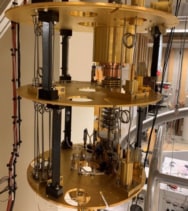
Quantum geometry plays a key role in allowing a material known as twisted bilayer graphene (tBLG) to become a superconductor, according to new experiments by physicists at The Ohio State University, The University of Texas at Dallas, and the National Institute for Materials Science in Japan. The finding implies that the widely employed Bardeen–Cooper–Schrieffer (BCS) equations for superconductors need to be modified for materials like tBLG that have very slow-moving charges. It may also help provide new guiding principles in the search for new superconductors that operate at higher temperatures, say the researchers.
Graphene is a two-dimensional crystal of carbon atoms arranged in a honeycomb pattern. This so-called “wonder material” boasts many exceptional properties, including high electrical conductivity as charge carriers (electrons and holes) zoom through the carbon lattice at very high speeds.
In 2018 researchers led by Pablo Jarillo-Herrero of MIT found that when two such sheets are placed on top of each other with a small angle misalignment, they form a structure known as a moiré superlattice. And when the twist angle between them reaches the (theoretically predicted) “magic angle” of 1.08°, this “twisted” bilayer configuration begins to show properties such as superconductivity below a certain critical temperature, Tc, – that is, it conducts electricity without any resistance.
At this angle, the way in which electrons move in the two coupled sheets changes because they are now forced to organize themselves at the same energy. This leads to “flat” electronic bands, in which electron states have exactly the same energy despite having different momenta. This flat band structure makes electrons dispersionless – that is, their kinetic energy becomes completely suppressed and they cannot move in the moiré lattice. The result is that the particles slow almost to a halt and become localized at specific positions along the coupled sheets.
A conduction paradox
In the new work, the researchers, led by Marc Bockrath and Jeanie Lau, showed that electrons in tBLG move with a speed as slow around 700–1200 m/s. This might seem fast in conventional terms, but is actually a factor of 1000 slower than the speed of electrons in monolayer graphene.
“This velocity constitutes an intrinsic speed for electrons in tBLG and hence also a limit to how much current the material can carry, whether it is superconducting or metallic,” explains Lau. “This slow speed gives rise to a paradox: how does tBLG conduct electricity, let alone superconduct, if the electrons move so slowly?”
“The answer is quantum geometry,” she says.
Ordinary geometry refers to how points or objects are related spatially – for example, how far apart they are and how they are connected. Quantum geometry is similar, but describes the quantum nature of electrons, which are not only particles but also waves, and thus have wavefunctions, and how these wavefunctions connect and interlink. “This contribution turns out to be critical to enable superconductivity,” Bockrath tells Physics World. “Instead of fast-moving electrons, the rich connections of electron wavefunctions are important.”
Most superconductors to date are described by the BCS theory (named after its discoverers, Bardeen, Cooper and Schrieffer). This theory explains why most metallic elements superconduct below their Tc: their fermionic electrons pair up to create bosons called Cooper pairs. These bosons form a phase-coherent condensate that can flow through the material as a supercurrent that does not experience scattering, and superconductivity is a consequence of this.

Short electrical pulses switch superconductivity on and off in magic-angle graphene
The theory falls short, however, when it comes to explaining the mechanisms behind high-temperature superconductors. Indeed, the mechanism underlying high-temperature superconductivity is regarded as one of the fundamental unsolved problems in physics.
“Our results show that the BCS equations also need to be modified for superconductors like tBLG with very slow-moving charges,” says Lau. “Our work may also provide new guiding principles in the search for new superconductors that can operate at higher temperatures than the known ones,” adds Bockrath.
The team will now continue to investigate tBLG to quantify and understand the role of quantum geometry in collaboration with theorists.
The research is detailed in Nature.
- SEO Powered Content & PR Distribution. Get Amplified Today.
- Platoblockchain. Web3 Metaverse Intelligence. Knowledge Amplified. Access Here.
- Source: https://physicsworld.com/a/quantum-effects-could-help-make-twisted-bilayer-graphene-a-superconductor/



